
Competitors in the elite women’s runners division cross the Verrazzano-Narrows Bridge during the 2019 New York City Marathon.
AP Photo/Julius Motal
Coaches often encourage young female athletes to lose weight, expecting the dropped pounds to improve their performance in athletic events. Indeed, several female runners came forward last year saying they were bullied about their weight by a Nike coach. Now, research suggests the strategy may do more harm than good.
“People equate fitness with thinness,” says Nieca Goldberg, a cardiologist at New York University’s Langone Health who was not involved with the work. “This study shows that we really need to rethink that.”
The belief that lighter is better may have come from small studies of athletic performance and body mass index (BMI), says James Guseh, a cardiovascular physician-scientist at Massachusetts General Hospital. BMI is a measure of height and weight, and some studies have shown that endurance athletes, such as long-distance runners or rowers, with low BMI outperform their heavier colleagues. But Guseh says most of this work has focused on male athletes.
So he and colleagues looked back at data from more than 2200 men and women referred from 2011 to 2019 to his hospital’s Cardiovascular Performance Program, which provides care and testing for athletes and other highly active individuals. The scientists assessed fitness by measuring the maximum amount of oxygen a person uses during aerobic exercise, also known as VO2 max. In a VO2 max test, participants’ oxygen consumption is measured during exercise on a treadmill or stationary bike. As they steadily pick up the pace, they use more oxygen. But oxygen consumption eventually levels out despite upping exercise intensity, indicating a person has reached their VO2 max.
It shows “how much your muscles can do before they are not getting enough oxygen,” says Rachel Lampert, a cardiologist at the Yale School of Medicine who was not involved with the study. Roughly, the higher your VO2 max score, the better your aerobic fitness.
The scientists then looked at how participants’ VO2 max scores related to their BMIs. For men and women over age 30, people with lower BMIs generally were more aerobically fit, the team reports this week at the virtual meeting Basic Cardiovascular Sciences Scientific Sessions. The association was not as strong in men under age 30.
For young women in the study, however, the relationship between BMI and fitness was very different. For those 235 study participants, VO2 max dipped at the low and high ends of measured BMI. The BMIs of extremely fit women clustered around 23, which for a woman 165 centimeters tall (5 feet, 5 inches) is roughly equivalent to weighing 63.5 kilograms (140 pounds).
That these female athletes fell on the higher end of the range of BMIs that the World Health Organization considers healthy, 18.5 to 24.9, suggests “being at a low weight may actually be counterproductive” to improving athletic performance, Guseh says.
The researchers are not sure why the relationship between BMI and fitness differs between young women and their male and older female counterparts. Guseh says differences in body composition could explain the trends. Older adults regardless of gender are more likely to have more fat tissue, he says, making a higher BMI likely to accompany lower athletic prowess. But the distribution of fat and muscle in young women is still changing. If a young female athlete loses too much weight, she could risk losing muscle, potentially slowing her down. The same could happen for male athletes, he says, which could explain why the relationship between lower BMI and high VO2 max was not as strong in younger men.
Weight loss can even be dangerous for young female athletes, Goldberg says, because it can lead to irregular periods, anemia, loss of bone density, and the development of eating disorders. Professional runner Mary Cain detailed her struggle with such issues during her involvement with Nike, alleging that she lost her period for 3 years and broke five bones because of her attempt to reach a coach’s prescribed weight.
The new findings, Goldberg says, suggest coaches should move away from weight loss. A better focus, she says, would be educating athletes about proper nutrition and sleep.
The researchers note some caveats to their conclusions. The team did not track whether a change in weight affected individual athletic performance over time, but instead looked at the general relationship between people’s weights and their aerobic endurance.
However, given the size and rigor of the study, Lampert says, it is clear that a lower weight does not always translate to better fitness. It is a reminder, Goldberg adds, that when considering athletic performance, weight isn’t everything.


